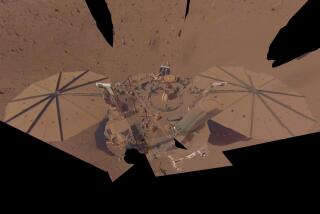Pebbles on Mars point to an ancient river in Gale Crater, study finds
- Share via
By examining the telltale contours of Martian pebbles spotted by NASA’s Curiosity rover, scientists say that they have found evidence of a river in Gale Crater that must have flowed for many miles.
The findings, published in the journal Nature Communications, add to the growing body of evidence that water flowed for extended periods on the surface of the Red Planet.
When Curiosity first discovered these rounded pebbles in 2013 not too far from its landing site in Gale Crater, researchers saw this as a sign of flowing water on the planet’s surface. After all, that’s how sharp fragments of rock get worn down into smooth stones on Earth: by being dragged along with a current and slammed into things over and over again.
See the most-read Science stories this hour >>
It’s a nice idea – but scientists didn’t know exactly how much the pebbles’ shapes would have corresponded with the distance they traveled. And pinning down that numerical relationship is important, because it helps determine whether the rocks really were taken by a river. If the rocks went just a short distance (for example, less than a mile or so) they were likely moved and polished by the wind. If they went a long distance (say, 50 miles) then they were probably transported by water.
“That really motivated us to say, can we do better?” said study coauthor Douglas Jerolmack, a geophysicist at the University of Pennsylvania. “If we have an image from a pebble on another planet, or on Earth for that matter, can we say something quantitative and definitive about how far that pebble has [been] transported?”
To put a number to the shapes, a team of researchers turned to Earth, examining the pebbles’ form and mass at different points in a river in Puerto Rico, tracking how they evolved from more jagged fragments at the start of their journey to smoother stones farther downstream. To see how shape varied in a more Mars-like environment, they examined stones at the Dog Canyon alluvial fan in New Mexico, which is somewhat similar to the Martian deposits. They even reduced the resolution on the images of those pebbles to match the resolution on Curiosity’s grainy cameras, and then analyzed them.
NEWSLETTER: Get essential California headlines delivered daily >>
Now that they knew the distance it took for a sharp rock to be worn into a smooth stone on Earth, the scientists applied this method to the images of pebbles spotted on Mars, taking into account (among other factors) the difference in the planet’s gravity and the hardness of the basaltic rock, which doesn’t erode as easily as the limestone in Dog Canyon. The researchers found that these pebbles must have traveled roughly 30 miles – long enough to be a sustained river.
“We could really start piecing together the plumbing of this river system on Mars,” Jerolmack said.
The findings, supported in part by the National Science Foundation, add to a growing body of evidence that Mars has had a watery past, with an atmosphere thick enough to keep liquid on the surface for extended periods of time. Last week, researchers using Curiosity data announced that Gale Crater must have held a series of lakes over time that rose and fell over millions of years. And there may even be small amounts of very briny water occasionally on the surface today, as recent discoveries using NASA’s Mars Reconnaissance Orbiter have shown.
Can’t get enough of the Red Planet? Follow @aminawrite for more Martian science news.
ALSO:
How ecotourists actually make things worse for wildlife
Cheers! For those managing diabetes, wine can help, study says
DNA from 4,500-year-old Ethiopian reveals surprise about ancestry of Africans





